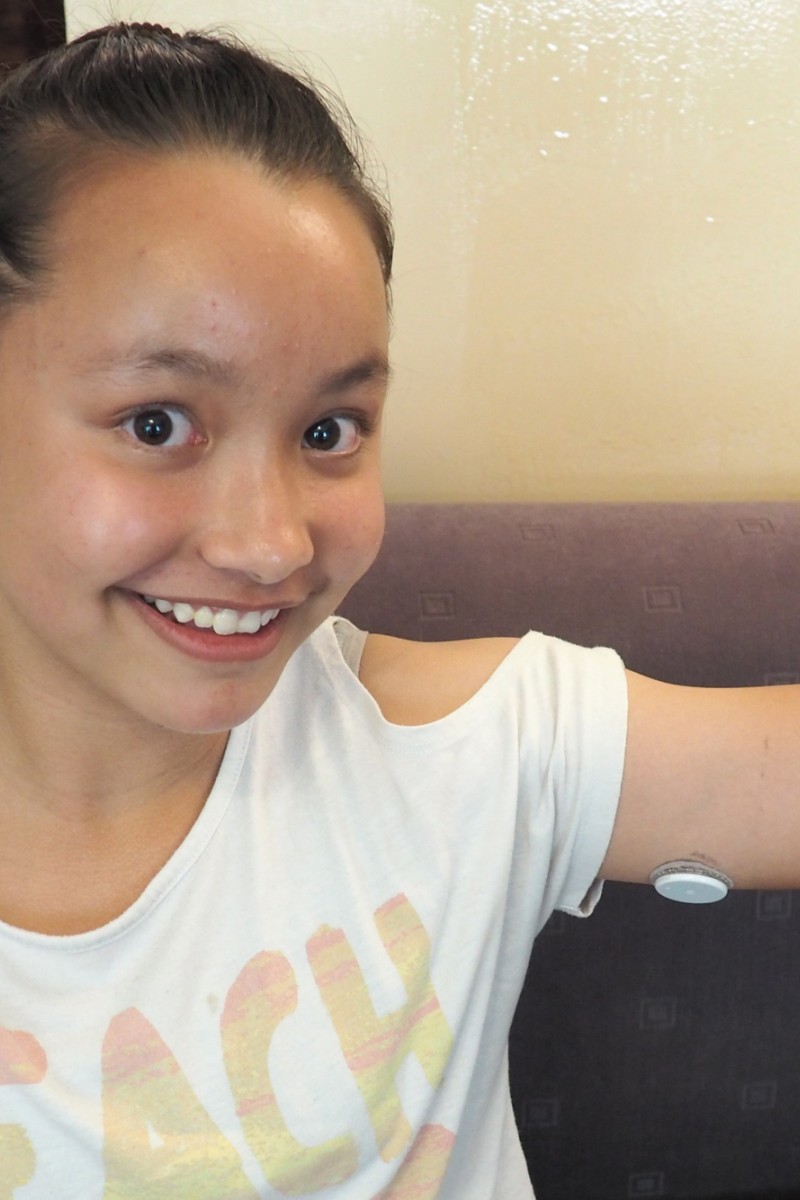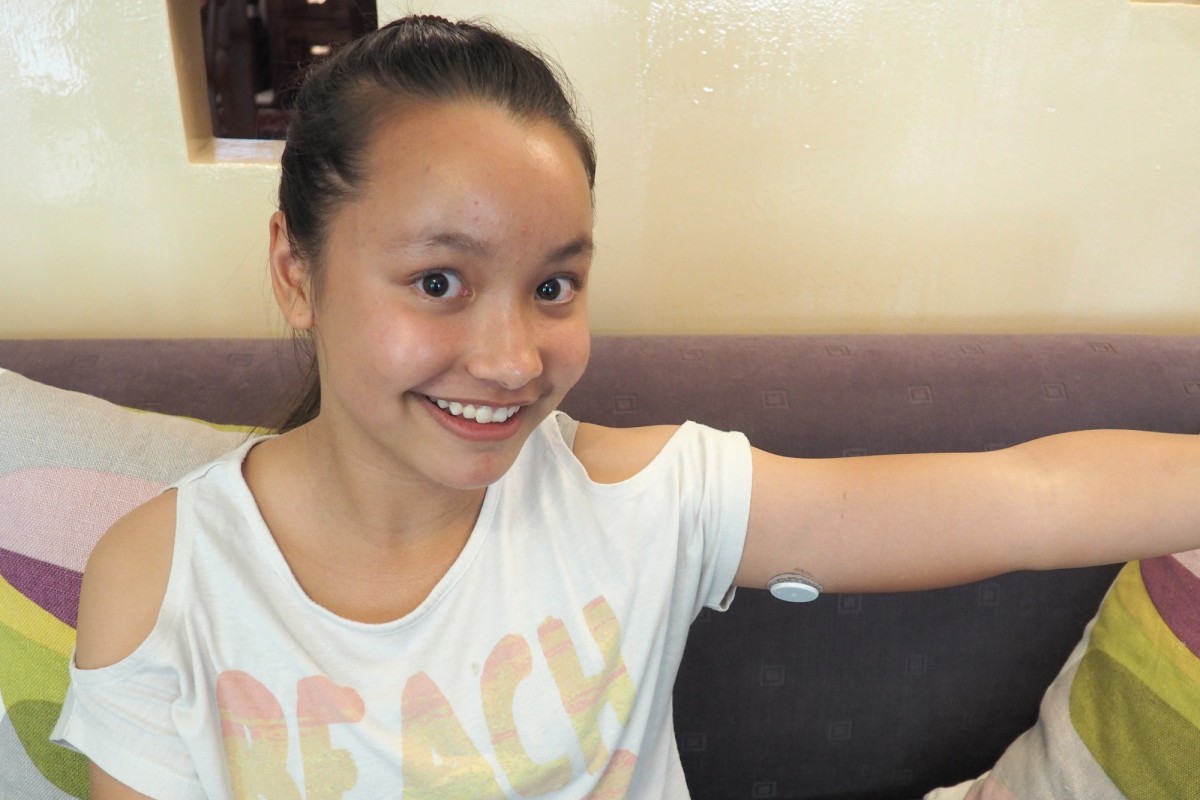
Wearable blood glucose sensor makes diabetes easier to live with
A sports-loving West Island Schooler tells Lauren James what it’s like living with type one diabetes, and why a new invention is changing the way she manages her condition
 Student Zoe Lister now uses the FreeStyle Libre to keep track of her blood glucose level.
Student Zoe Lister now uses the FreeStyle Libre to keep track of her blood glucose level.Until Zoe Lister discovered the FreeStyle Libre, managing her diabetes was a lot more hassle. Instead of pricking her finger to test her blood sugar, all the 13-year-old Hongkonger has to do now is scan a tiny, white circular sensor attached to the underside of her arm.
Zoe was diagnosed with diabetes when she was just five, after her family noticed that she was drinking an abnormally high amount of water and was throwing terrible tantrums. A doctor’s test found the amount of sugar in her blood was very high - a sign of diabetes. From then on, she has had to constantly monitor her blood sugar level.
“It was a big change, because we’d have to check at all meals and at night. We didn’t know how bad I could go hypo,” she told Young Post last month. “Hypo” means hypoglycaemic, when blood glucose levels become dangerously low.
Zoe has type one diabetes, which means her body produces little to no insulin – a hormone the body needs to use sugar. Those who have the more common type two diabetes, on the other hand, can’t use the insulin in their bodies properly. Patients with either form of diabetes need to keep track of their blood glucose level (BGL).
The finger-prick test, which involves taking a tiny amount of blood from the fingertip and dropping it onto a testing device, is the most common way to do this. After testing their blood sugar, patients need to inject themselves with insulin to help the body function.
Until Zoe was nine, her parents would do her tests and inject her with insulin. But that meant they had to go everywhere with her. Soon, Zoe wanted more independence – especially at birthday parties – so she learned to do it by herself.
“I was really nervous,” she remembers. “It took me a few tries because I was poking it in and taking it out very fast because I was so scared. But finally, I learned to leave it in and inject the insulin. It felt like an accomplishment.”
With the finger-pricking, Zoe would need to prick herself between 10 and 15 times every day, which can be damaging to the skin. When she was at school, it would be easy to forget to finger-prick, especially if she was playing sports at lunch. Now that she has the FreeStyle Libre, checking is a lot faster and easier.
Zoe attaches a sticky sensor about the size of a five dollar coin to her arm, where it stays for two weeks. Sticking out from the underside of the sensor is a tiny, soft filament, which slips painlessly beneath the surface of the skin.
“You can feel it at first, but after I’ve been wearing it for a while, I forget it’s there,” says Zoe. Each sensor, priced at HK$520, lasts for 14 days, after which it must be discarded and replaced with a new one.
Zoe likens the electronic reader to an Octopus card – it is held next to the sensor to get a reading. One advantage of the Libre system is the ability to see a graph of her recent readings which can be also be saved on her computer for long-term record-keeping.
She loves sports, and plays rugby, basketball and netball. But exercise can make her blood sugar drop quickly. “When I was finger pricking, my parents were always worried about my levels. With the Libre, I can check before and after sports. It helps me be more cautious and aware,” she explains.
Unlike finger-pricking, which can be carried out discreetly, Zoe’s sensor is always on her arm and can attract attention. However, she and her family have always been very open about her condition, and, if anyone asks, she is happy to explain what it does and why she wears it.
“It was hard telling my friends about my diabetes when I was diagnosed, because they hadn’t heard of it before,” she recalls. “So I had to explain how my pancreas doesn't work to supply the insulin I need so I had to manage it myself.” Now, Zoe’s friends are often the first to realise when she is pale – one of the key warning signs of hypoglycaemia.
For Zoe’s mum, Cassandra, the Libre has made a big difference when the family is travelling. She says, “There have been times on planes where we’ve dropped insulin pens or covers for the needles, and had airline staff crawling around with torches trying to find them.” And now, when she goes to check Zoe late at night, she doesn’t need to wake up her daughter with a sharp pain in her finger. “It’s effective, efficient and convenient,” Cassandra adds.
More than 568,000 people in Hong Kong currently live with diabetes, and this figure is predicted to rise sharply over the next few decades. A recent survey by Diabetes Hong Kong and the Asia Diabetes Foundation found that three out of four Hongkongers with diabetes weren’t controlling their glucose properly – and the inconvenience of finger-pricking was one of the reasons why. The FreeStyle Libre is out of many people’s budgets, but the charity Youth Diabetes Action is lobbying the government to subsidise the kits, which will make them more affordable.
If there’s one thing Zoe wants others to take away from her experience, it’s that a healthy diet is important – whether you have diabetes or not. She says, “I’m very careful with my food intake and that’s a good message to pass on. Everyone should be aware of the food they take into their bodies.”
